Citroen GRAND C4 PICASSO RHD 2017 2.G Owner's Manual
Manufacturer: CITROEN, Model Year: 2017, Model line: GRAND C4 PICASSO RHD, Model: Citroen GRAND C4 PICASSO RHD 2017 2.GPages: 523, PDF Size: 11.96 MB
Page 231 of 523
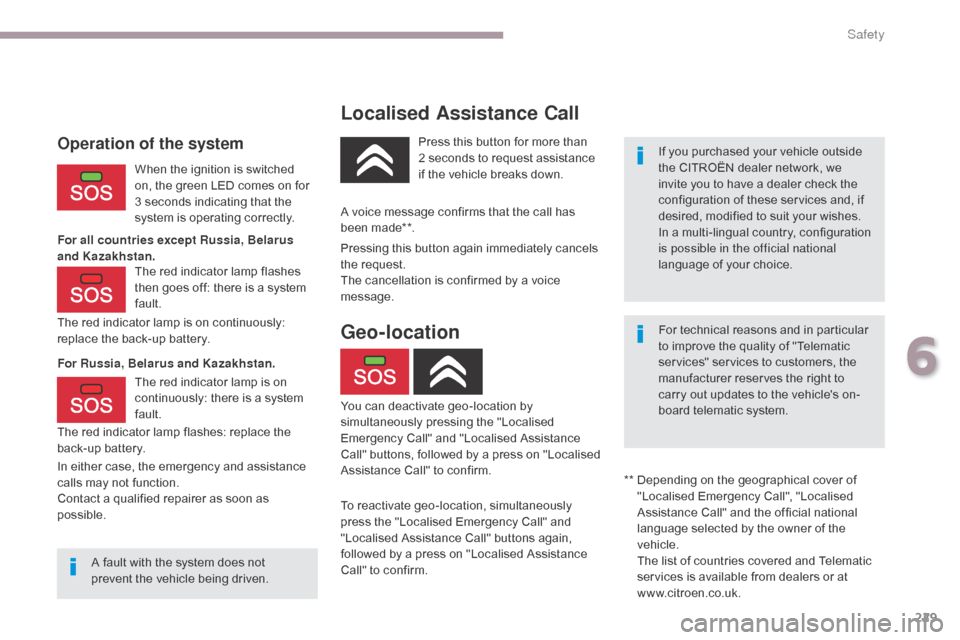
229
Localised Assistance Call
If you purchased your vehicle outside
the CITROËN dealer network, we
invite you to have a dealer check the
configuration of these services and, if
desired, modified to suit your wishes.
In a multi-lingual country, configuration
is possible in the official national
language of your choice.
A fault with the system does not
prevent the vehicle being driven. For technical reasons and in particular
to improve the quality of "Telematic
services" services to customers, the
manufacturer reserves the right to
carry out updates to the vehicle's on-
board telematic system.
A voice message confirms that the call has
been made**.
**
D
epending on the geographical cover of
"Localised Emergency Call", "Localised
Assistance Call" and the official national
language selected by the owner of the
vehicle.
The list of countries covered and Telematic
services is available from dealers or at
www.citroen.co.uk.Operation of the system
When the ignition is switched
on, the green LED comes on for
3 seconds indicating that the
system is operating correctly.
The red indicator lamp flashes
then goes off: there is a system
fault.
For all countries except Russia, Belarus
and Kazakhstan.
The red indicator lamp is on continuously:
replace the back-up battery.
For Russia, Belarus and Kazakhstan.
The red indicator lamp is on
continuously: there is a system
fault.
The red indicator lamp flashes: replace the
back-up battery.
In either case, the emergency and assistance
calls may not function.
Contact a qualified repairer as soon as
possible. Press this button for more than
2
seconds to request assistance
if the vehicle breaks down.
Pressing this button again immediately cancels
the request.
The cancellation is confirmed by a voice
message.
Geo-location
You can deactivate geo-location by
simultaneously pressing the "Localised
Emergency Call" and "Localised Assistance
Call" buttons, followed by a press on "Localised
Assistance Call" to confirm.
To reactivate geo-location, simultaneously
press the "Localised Emergency Call" and
"Localised Assistance Call" buttons again,
followed by a press on "Localised Assistance
Call" to confirm.
6
Safety
Page 232 of 523
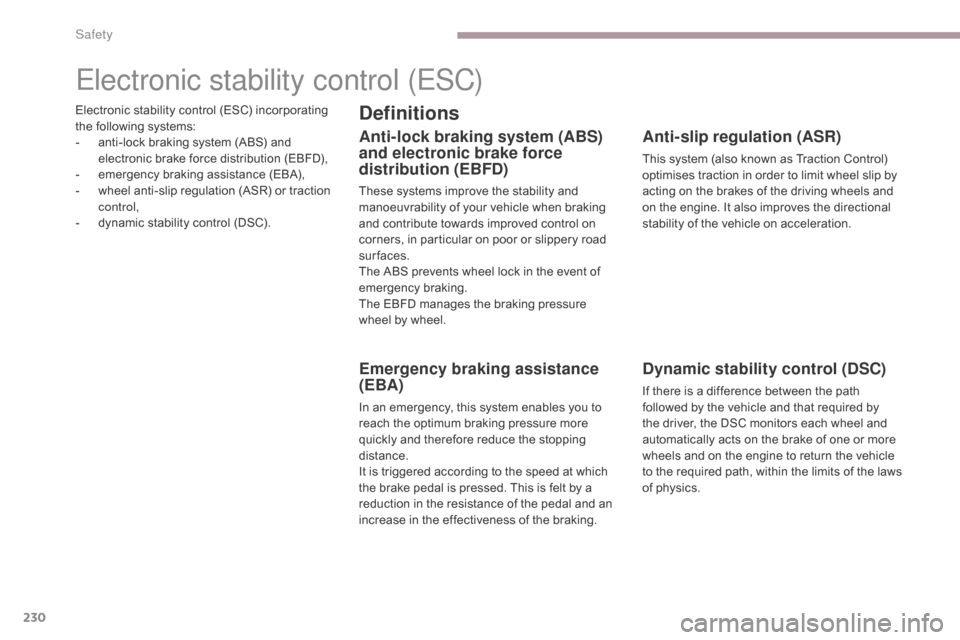
230
Electronic stability control (ESC) incorporating
the following systems:
-
a
nti-lock braking system (ABS) and
electronic brake force distribution (EBFD),
-
e
mergency braking assistance (EBA),
-
w
heel anti-slip regulation (ASR) or traction
control,
-
d
ynamic stability control (DSC).
Electronic stability control (ESC)
Definitions
Anti-lock braking system (ABS)
and electronic brake force
distribution (EBFD)
These systems improve the stability and
manoeuvrability of your vehicle when braking
and contribute towards improved control on
corners, in particular on poor or slippery road
surfaces.
The ABS prevents wheel lock in the event of
emergency braking.
The EBFD manages the braking pressure
wheel by wheel.
Emergency braking assistance
(EBA)
In an emergency, this system enables you to
reach the optimum braking pressure more
quickly and therefore reduce the stopping
distance.
It is triggered according to the speed at which
the brake pedal is pressed. This is felt by a
reduction in the resistance of the pedal and an
increase in the effectiveness of the braking.
Anti-slip regulation (ASR)
This system (also known as Traction Control)
optimises traction in order to limit wheel slip by
acting on the brakes of the driving wheels and
on the engine. It also improves the directional
stability of the vehicle on acceleration.
Dynamic stability control (DSC)
If there is a difference between the path
followed by the vehicle and that required by
the driver, the DSC monitors each wheel and
automatically acts on the brake of one or more
wheels and on the engine to return the vehicle
to the required path, within the limits of the laws
of physics.
Safety
Page 233 of 523
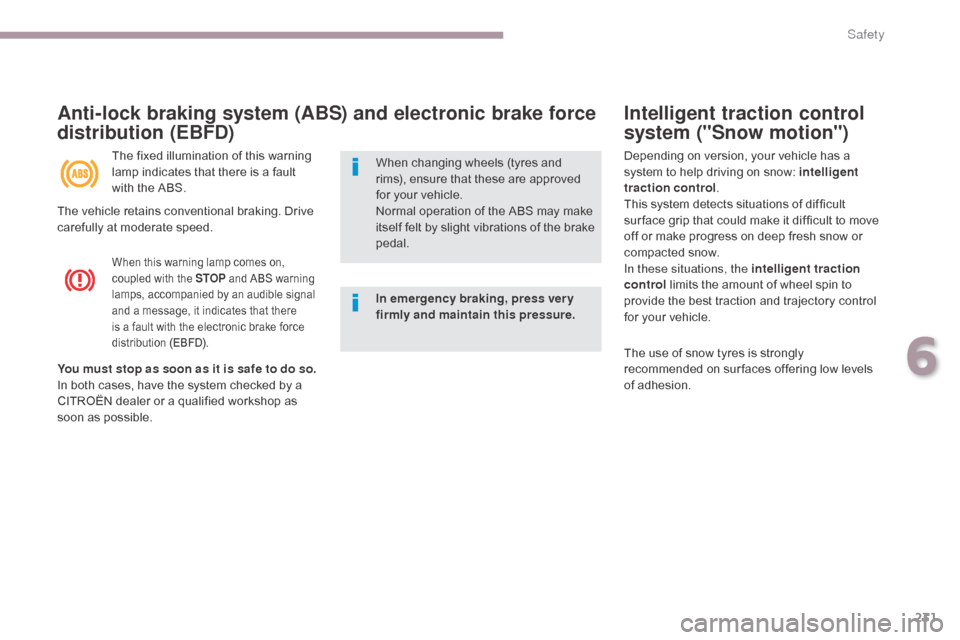
231
Intelligent traction control
system ("Snow motion")
When this warning lamp comes on,
coupled with the STOP and ABS warning
lamps, accompanied by an audible signal
and a message, it indicates that there
is a fault with the electronic brake force
distribution (EBFD).
Anti-lock braking system (ABS) and electronic brake force
distribution (EBFD)
The fixed illumination of this warning
lamp indicates that there is a fault
with the ABS. Depending on version, your vehicle has a
system to help driving on snow: intelligent
traction control
.
This system detects situations of difficult
sur face grip that could make it difficult to move
off or make progress on deep fresh snow or
compacted snow.
In these situations, the intelligent traction
control limits the amount of wheel spin to
provide the best traction and trajectory control
for your vehicle.
The use of snow tyres is strongly
recommended on sur faces offering low levels
of adhesion.
When changing wheels (tyres and
rims), ensure that these are approved
for your vehicle.
Normal operation of the ABS may make
itself felt by slight vibrations of the brake
pedal.
In emergency braking, press ver y
firmly and maintain this pressure.
You must stop as soon as it is safe to do so.
In both cases, have the system checked by a
CITROËN dealer or a qualified workshop as
soon as possible. The vehicle retains conventional braking. Drive
carefully at moderate speed.
6
Safety
Page 234 of 523
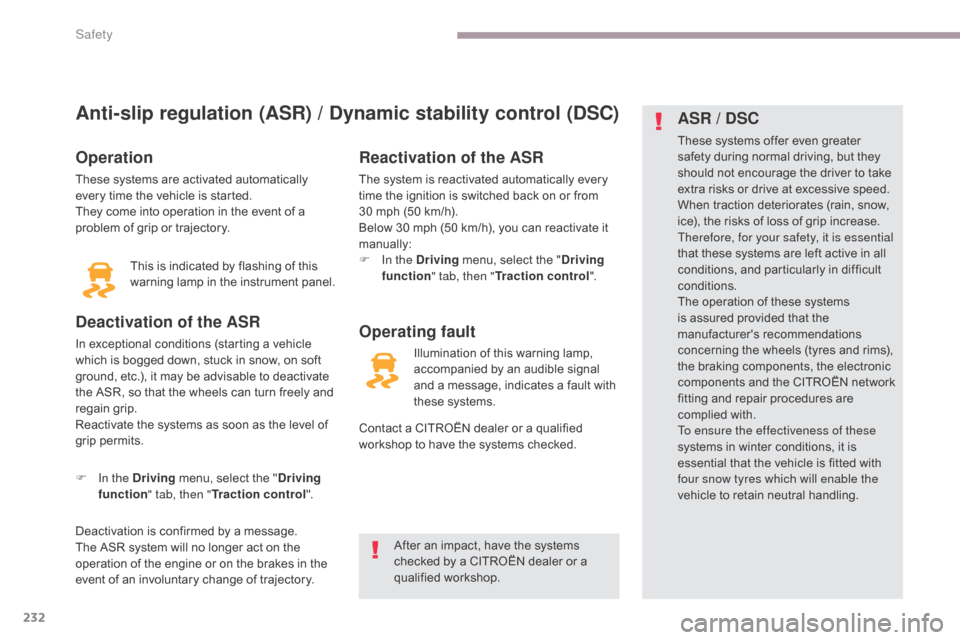
232
Anti-slip regulation (ASR) / Dynamic stability control (DSC)
Operation
These systems are activated automatically
every time the vehicle is started.
They come into operation in the event of a
problem of grip or trajectory.
Deactivation of the ASR
In exceptional conditions (starting a vehicle
which is bogged down, stuck in snow, on soft
ground, etc.), it may be advisable to deactivate
the ASR, so that the wheels can turn freely and
regain grip.
Reactivate the systems as soon as the level of
grip permits.This is indicated by flashing of this
warning lamp in the instrument panel.
F
I
n the Driving menu, select the " Driving
function " tab, then " Traction control".
Deactivation is confirmed by a message.
The ASR system will no longer act on the
operation of the engine or on the brakes in the
event of an involuntary change of trajectory.Operating fault Reactivation of the ASR
The system is reactivated automatically every
time the ignition is switched back on or from
30 mph (50 km/h).
Below 30 mph (50 km/h), you can reactivate it
manually:
F
I
n the Driving menu, select the " Driving
function " tab, then " Traction control".
Illumination of this warning lamp,
accompanied by an audible signal
and a message, indicates a fault with
these systems.
Contact a CITROËN dealer or a qualified
workshop to have the systems checked.
ASR / DSC
These systems offer even greater
safety during normal driving, but they
should not encourage the driver to take
extra risks or drive at excessive speed.
When traction deteriorates (rain, snow,
ice), the risks of loss of grip increase.
Therefore, for your safety, it is essential
that these systems are left active in all
conditions, and particularly in difficult
conditions.
The operation of these systems
is assured provided that the
manufacturer's recommendations
concerning the wheels (tyres and rims),
the braking components, the electronic
components and the CITROËN
network
fitting and repair procedures are
complied with.
To ensure the effectiveness of these
systems in winter conditions, it is
essential that the vehicle is fitted with
four snow tyres which will enable the
vehicle to retain neutral handling.
After an impact, have the systems
checked by a CITROËN dealer or a
qualified workshop.
Safety
Page 235 of 523
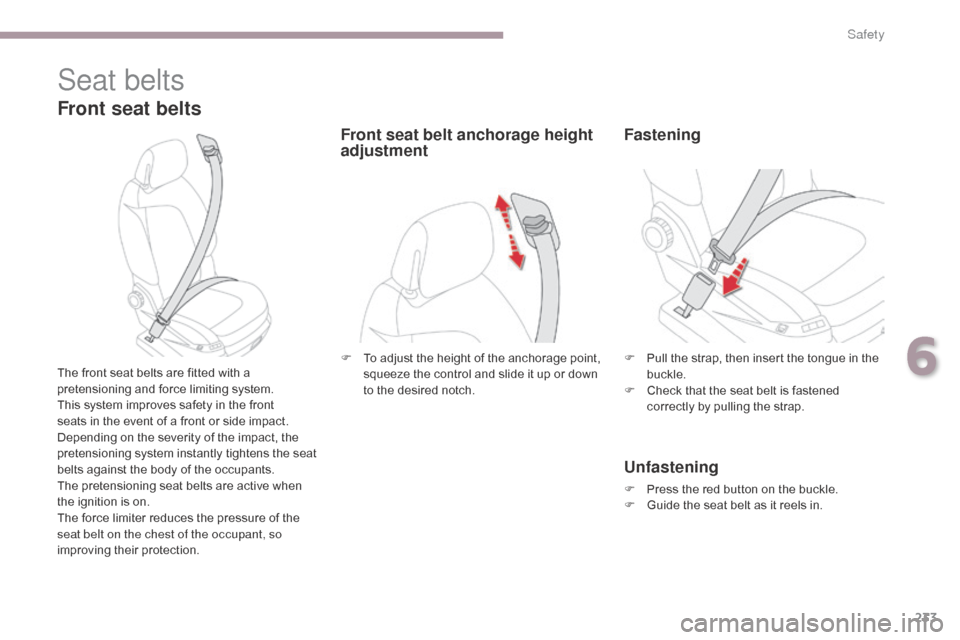
233
Seat belts
Front seat belts
The front seat belts are fitted with a
pretensioning and force limiting system.
This system improves safety in the front
seats in the event of a front or side impact.
Depending on the severity of the impact, the
pretensioning system instantly tightens the seat
belts against the body of the occupants.
The pretensioning seat belts are active when
the ignition is on.
The force limiter reduces the pressure of the
seat belt on the chest of the occupant, so
improving their protection.F
T o adjust the height of the anchorage point,
squeeze the control and slide it up or down
to the desired notch. F
P ull the strap, then insert the tongue in the
buckle.
F
C
heck that the seat belt is fastened
correctly by pulling the strap.
Unfastening
F Press the red button on the buckle.
F G uide the seat belt as it reels in.
Front seat belt anchorage height
adjustment Fastening
6
Safety
Page 236 of 523
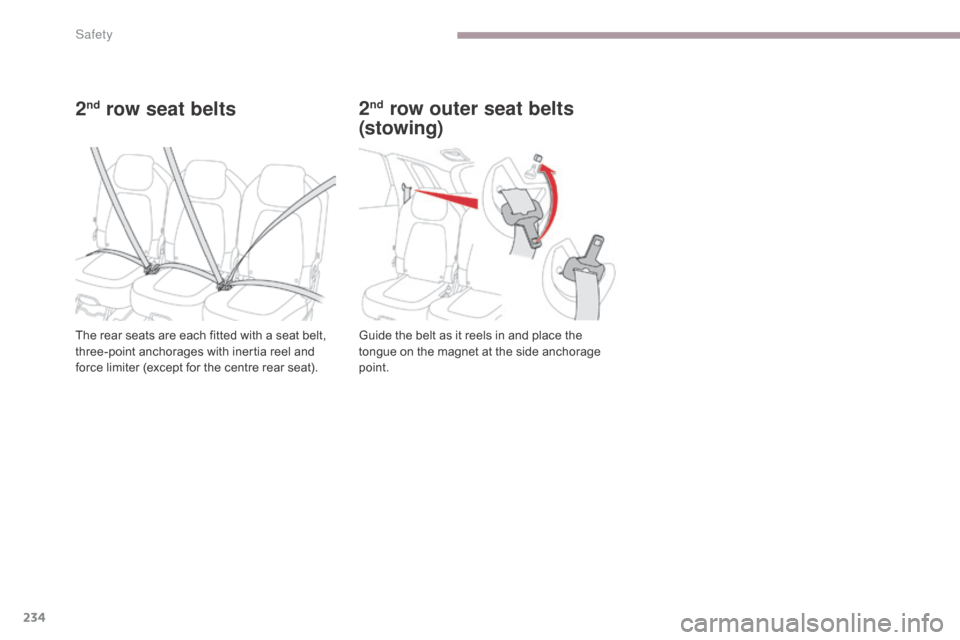
234
2nd row seat belts
The rear seats are each fitted with a seat belt,
three-point anchorages with inertia reel and
force limiter (except for the centre rear seat).Guide the belt as it reels in and place the
tongue on the magnet at the side anchorage
point.
2nd row outer seat belts
(stowing)
Safety
Page 237 of 523
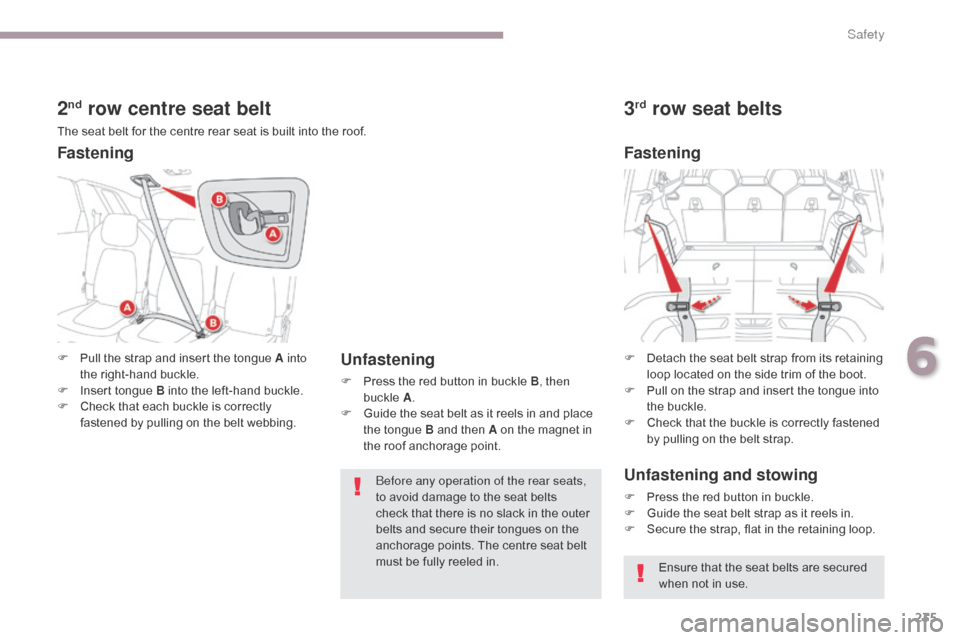
235
2nd row centre seat belt
The seat belt for the centre rear seat is built into the roof.
F
P
ull the strap and insert the tongue A into
the right-hand buckle.
F
I
nsert tongue B into the left-hand buckle.
F
C
heck that each buckle is correctly
fastened by pulling on the belt webbing.
Unfastening
F Press the red button in buckle B , then
buckle A.
F
G
uide the seat belt as it reels in and place
the tongue B and then A on the magnet in
the roof anchorage point.
Before any operation of the rear seats,
to avoid damage to the seat belts
check that there is no slack in the outer
belts and secure their tongues on the
anchorage points. The centre seat belt
must be fully reeled in.
3rd row seat belts
F Detach the seat belt strap from its retaining loop located on the side trim of the boot.
F
P
ull on the strap and insert the tongue into
the buckle.
F
C
heck that the buckle is correctly fastened
by pulling on the belt strap.
Unfastening and stowing
F Press the red button in buckle.
F G uide the seat belt strap as it reels in.
F
S
ecure the strap, flat in the retaining loop.
Ensure that the seat belts are secured
when not in use.
Fastening Fastening
6
Safety
Page 238 of 523
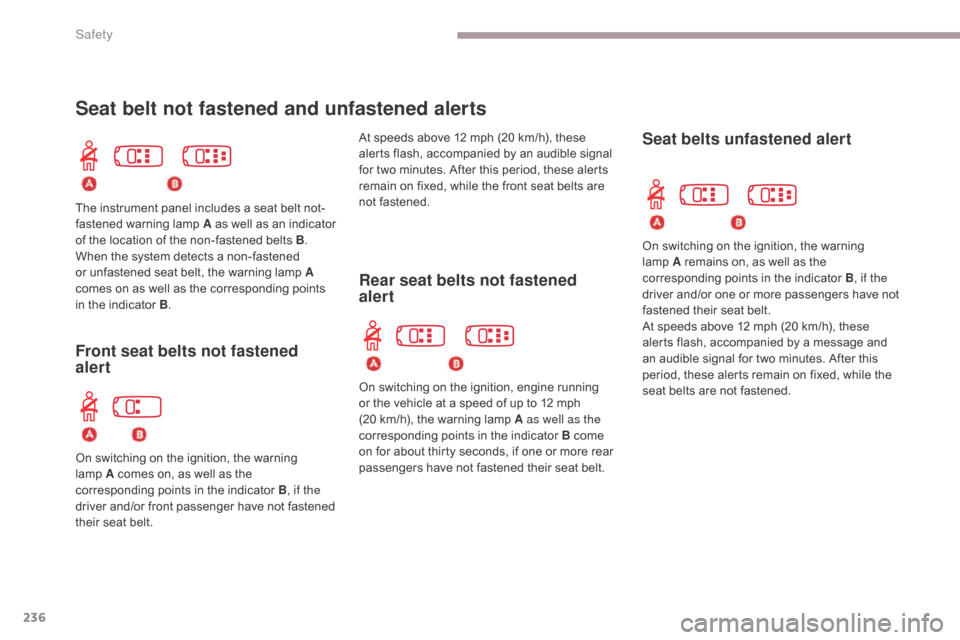
236
Seat belt not fastened and unfastened alerts
Rear seat belts not fastened
alert
The instrument panel includes a seat belt not-
fastened warning lamp A as well as an indicator
of the location of the non-fastened belts B .
When the system detects a non-fastened
or unfastened seat belt, the warning lamp A
comes on as well as the corresponding points
in the indicator B .
On switching on the ignition, engine running
or the vehicle at a speed of up to 12 mph
(20 km/h), the warning lamp A as well as the
corresponding points in the indicator B come
on for about thirty seconds, if one or more rear
passengers have not fastened their seat belt.
Seat belts unfastened alert
Front seat belts not fastened
alert
On switching on the ignition, the warning
lamp A comes on, as well as the
corresponding
points in the indicator B , if the
driver and/or front passenger have not fastened
their seat belt. At speeds above 12 mph (20 km/h), these
alerts flash, accompanied by an audible signal
for two minutes. After this period, these alerts
remain on fixed, while the front seat belts are
not fastened.
On switching on the ignition, the warning
lamp
A
remains on, as well as the
corresponding points in the indicator B , if the
driver and/or one or more passengers have not
fastened their seat belt.
At speeds above 12 mph (20 km/h), these
alerts flash, accompanied by a message and
an audible signal for two minutes. After this
period, these alerts remain on fixed, while the
seat belts are not fastened.
Safety
Page 239 of 523
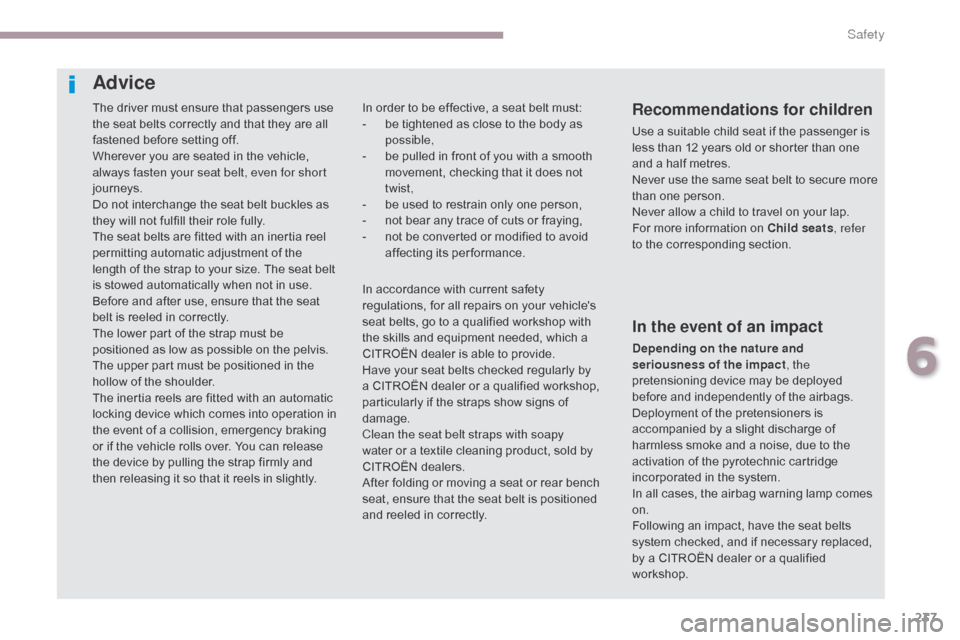
237
The driver must ensure that passengers use
the seat belts correctly and that they are all
fastened before setting off.
Wherever you are seated in the vehicle,
always fasten your seat belt, even for short
journeys.
Do not interchange the seat belt buckles as
they will not fulfill their role fully.
The seat belts are fitted with an inertia reel
permitting automatic adjustment of the
length of the strap to your size. The seat belt
is stowed automatically when not in use.
Before and after use, ensure that the seat
belt is reeled in correctly.
The lower part of the strap must be
positioned as low as possible on the pelvis.
The upper part must be positioned in the
hollow of the shoulder.
The inertia reels are fitted with an automatic
locking device which comes into operation in
the event of a collision, emergency braking
or if the vehicle rolls over. You can release
the device by pulling the strap firmly and
then releasing it so that it reels in slightly.Recommendations for children
Use a suitable child seat if the passenger is
less than 12 years old or shorter than one
and a half metres.
Never use the same seat belt to secure more
than one person.
Never allow a child to travel on your lap.
For more information on Child seats, refer
to the corresponding section.
In order to be effective, a seat belt must:
-
b
e tightened as close to the body as
possible,
-
b
e pulled in front of you with a smooth
movement, checking that it does not
twist,
-
b
e used to restrain only one person,
-
n
ot bear any trace of cuts or fraying,
-
n
ot be converted or modified to avoid
affecting its performance.
In the event of an impact
Depending on the nature and
seriousness of the impact , the
pretensioning device may be deployed
before and independently of the airbags.
Deployment of the pretensioners is
accompanied by a slight discharge of
harmless smoke and a noise, due to the
activation of the pyrotechnic cartridge
incorporated in the system.
In all cases, the airbag warning lamp comes
on.
Following an impact, have the seat belts
system checked, and if necessary replaced,
by a CITROËN dealer or a qualified
workshop.
In accordance with current safety
regulations, for all repairs on your vehicle's
seat belts, go to a qualified workshop with
the skills and equipment needed, which a
CITROËN dealer is able to provide.
Have your seat belts checked regularly by
a CITROËN dealer or a qualified workshop,
particularly if the straps show signs of
damage.
Clean the seat belt straps with soapy
water or a textile cleaning product, sold by
CITROËN dealers.
After folding or moving a seat or rear bench
seat, ensure that the seat belt is positioned
and reeled in correctly.
Advice
6
Safety
Page 240 of 523
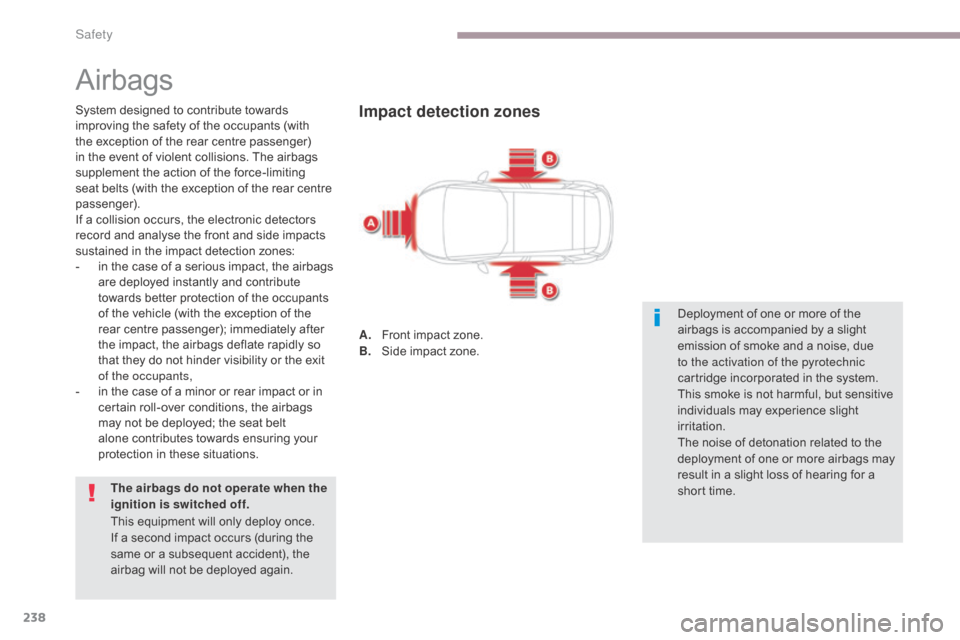
238
Airbags
System designed to contribute towards
improving the safety of the occupants (with
the exception of the rear centre passenger)
in the event of violent collisions. The airbags
supplement the action of the force-limiting
seat belts (with the exception of the rear centre
passenger).
If a collision occurs, the electronic detectors
record and analyse the front and side impacts
sustained in the impact detection zones:
-
i
n the case of a serious impact, the airbags
are deployed instantly and contribute
towards better protection of the occupants
of the vehicle (with the exception of the
rear centre passenger); immediately after
the impact, the airbags deflate rapidly so
that they do not hinder visibility or the exit
of the occupants,
-
i
n the case of a minor or rear impact or in
certain roll-over conditions, the airbags
may not be deployed; the seat belt
alone contributes towards ensuring your
protection in these situations.
The airbags do not operate when the
ignition is switched off.
This equipment will only deploy once.
If a second impact occurs (during the
same or a subsequent accident), the
airbag will not be deployed again. Deployment of one or more of the
airbags is accompanied by a slight
emission of smoke and a noise, due
to the activation of the pyrotechnic
cartridge incorporated in the system.
This smoke is not harmful, but sensitive
individuals may experience slight
irritation.
The noise of detonation related to the
deployment of one or more airbags may
result in a slight loss of hearing for a
short time.
A.
F
ront impact zone.
B.
S
ide impact zone.Impact detection zones
Safety